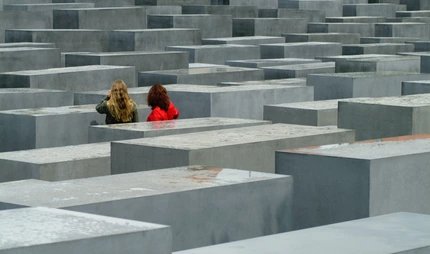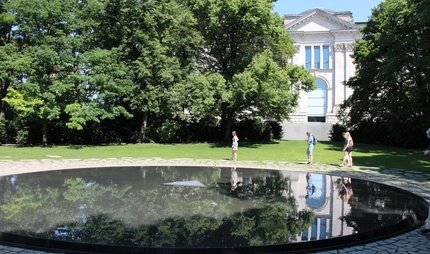
Book burning memorial at Bebelplatz
Where once books were burnt…
Don’t miss Micha Ullman’s spatial installation: a library with empty shelves commemorates the book-burning at Bebelplatz.
When you stroll across Bebelplatz you often come across people staring at the same spot on the ground. When you get closer, you see a glass plate set in the paving stones, and below it an underground room with empty bookshelves.
The sunken library
The memorial shows what is missing. Underground, almost out of sight, no books, empty white shelves, directly under the Bebelplatz. What was lost and burnt were the books by those who the Nazis ostracised and persecuted, who had to leave the country and whose stories were no longer allowed to be told. Symbolically, the underground bookshelves have space for around 20,000 books, as a reminder of the 20,000 books that went up in flames here on 10 May 1933 at the behest of the Nazis. The Israeli artist Micha Ullman designed the library memorial, which was unveiled on 20 March 1995.

Two bronze plates also set in the ground contain information and an inscription with the warning:
That was but a prelude;
where they burn books,
they will ultimately burn people as well.
Heinrich Heine 1820
In the middle of the square on 10 May 1933, Nazi students burnt the works of hundreds of independent authors, journalists, philosophers and academics.
The book-burning
On 10 May 1933, members of the Nazi German Student Union and their professors burnt books as part of a nationwide action “against the un-German spirit”.
The books to be burnt were chosen according to blacklists made by the librarian Wolfgang Herrmann, which were then used to plunder private bookshelves, public libraries and academic collections. Before the books were burnt, the organisers sent out what they called their “Twelve Theses”, which were to be read at the book-burnings in every town. With the words “Against decadence and moral decay! For discipline and decency in the family and the nation! I commit to the flames the writings of Heinrich Mann, Ernst Glaeser and Erich Kästner”, Kästner’s novel “Fabian” was tossed onto the fire.
As well as Kästner, the blacklisted authors included Sigmund Freud, Karl Marx, Heinrich and Klaus Mann, Rosa Luxemburg, August Bebel, Bertha von Suttner and Stefan Zweig. Many of the vilified and persecuted writers had already left Germany and gone into exile.
Erich Kästner stood watching unrecognised as his book Fabian was consumed by the flames. Later he described this dark day with the word “Begräbniswetter” (funeral weather). It rained so hard that the flames kept going out, and the fire brigade had to pour petrol on the fire to get it burning properly.



